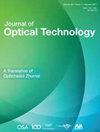相干照明和散斑减少的光束扩展器
IF 0.6
4区 物理与天体物理
Q4 OPTICS
引用次数: 0
摘要
研究主题。研究了基于全息光学元件和光波导的组合光学元件。研究目的。研究的目的是发展紧凑型光学系统,将具有高斯能量分布的准直光束从相干辐射源转换成具有放大尺寸的均匀截面光束。方法。相干辐射通过全息光学元件耦合到光导中或从光导中耦合出来。光导和匹配的散射体创建了大量的次级点光源。这些源通过干涉结合在一起,产生具有必要的能量分布和孔径的总场。主要的结果。在全息光学元件和光波导的基础上,对组合光学元件进行了改进。这些元件的总效率为40%-45%(单个元件的衍射效率为80% - 85%),光束均匀性约为80%,散斑对比度降低到20%-30%的水平。现实意义。所提出的基于光导和全息光学元件的组合光学元件开发技术方案可以显著降低可视化系统,特别是可穿戴虚拟现实和增强现实设备的能耗、尺寸和重量。本文章由计算机程序翻译,如有差异,请以英文原文为准。
Beam expanders for coherent illumination and speckle reduction
Subject of study. Optical elements combined based on holographic optical elements and a lightguide are studied. Aim of study. The aim of the study is the development of compact optical systems to convert a collimated beam with Gaussian energy distribution from a coherent radiation source into a uniform homogeneous cross-sectional beam with enlarged dimensions. Method. Coherent radiation is coupled into and outcoupled from the lightguide using holographic optical elements. The lightguide and the matched scatterer create a multitude of secondary point sources. These sources combine through interference to generate a total field with the necessary energy distribution and aperture. Main results. The authors propose several modifications for the combined optical elements based on holographic optical elements and a lightguide. The total efficiency of these elements is 40%–45% (the diffraction efficiency of individual elements is 80%–85%) with a beam uniformity of approximately 80% and a decrease in speckle contrast to the level of 20%–30%. Practical significance. The proposed technical solutions with regard to the development of combined optical elements based on lightguides and holographic optical elements can significantly reduce the energy consumption, dimensions, and weight of visualization systems, specifically wearable virtual and augmented reality devices.
求助全文
通过发布文献求助,成功后即可免费获取论文全文。
去求助
来源期刊
CiteScore
0.90
自引率
25.00%
发文量
66
审稿时长
3-8 weeks
期刊介绍:
The journal publishes design details of a diversity of optical instruments, along with a strong section on computational optics useful to engineers, mathematicians, and physicists, as well as optical scientists. Issues of the English translation volume are published by OSA and appear at the same time as the Russian language edition, Opticheskii Zhurnal, which is produced by the Vavilov State Optical Institute

 求助内容:
求助内容: 应助结果提醒方式:
应助结果提醒方式:


